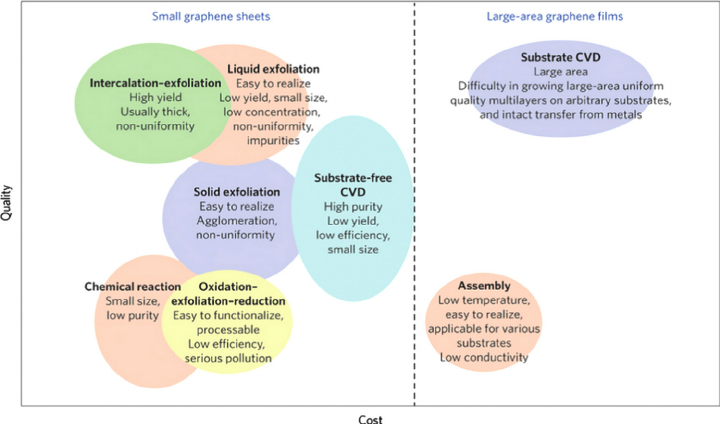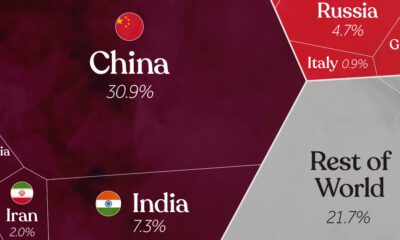Technology
Graphene: The Game-Changing Material of the Future
Technology is only as good as the materials it is made from.
Much of the modern information era would not be possible without silicon and Moore’s Law, and electric cars would be much less viable without recent advances in the material science behind lithium-ion batteries.
That’s why graphene, a two-dimensional supermaterial made from carbon, is so exciting. It’s harder than diamonds, 300x stronger than steel, flexible, transparent, and a better conductor than copper (by about 1,000x).
If it lives up to its potential, graphene could revolutionize everything from computers to energy storage.
Graphene: Is It the Next Wonder Material?
The following infographic comes to us from 911Metallurgist, and it breaks down the incredible properties and potential applications of graphene.

While the properties and applications of graphene are extremely enticing, there has one big traditional challenge with graphene: the cost of getting it.
The Ever-Changing Graphene Price
As you can imagine, synthesizing a material that is one atom thick is a process that has some major limitations. Since a sheet of graphene 1 mm thick (1/32 of an inch) requires three million layers of atoms, graphene has been quite cost-prohibitive to produce in large amounts.
Back in 2013, Nature reported that one micrometer-sized flake of graphene costed more than $1,000, which made graphene one of the most expensive materials on Earth. However, there has been quite some progress in this field since then, as scientists search for the “Holy Grail” in scaling graphene production processes.
By the end of 2015, Deloitte estimated that the market price per gram was close to $100. And today, graphene can now be ordered straight from a supplier like Graphenea, where multiple products are offered online ranging from graphene oxide (water dispersion) to monolayer graphene on silicon wafers.
One producer, NanoXplore, even estimates that graphene is now down to a cost of $0.10 per gram for good quality graphene, though this excludes graphene created through a CVD process (recognized as the highest level of quality available for bulk graphene).
The following graphic from Nature (2014) shows some methods for graphene production – though it should be noted that this is a quickly-changing discipline.

As the price of graphene trends down at an impressive rate, its applications will continue to grow. However, for graphene to be a true game-changer, it will have to be integrated into the supply chains of manufacturers, which will still take multiple years to accomplish.
Once graphene has “real world” applications, we’ll be able to see what can be made possible on a grander scale.
Technology
Ranked: Semiconductor Companies by Industry Revenue Share
Nvidia is coming for Intel’s crown. Samsung is losing ground. AI is transforming the space. We break down revenue for semiconductor companies.
Semiconductor Companies by Industry Revenue Share
This was originally posted on our Voronoi app. Download the app for free on Apple or Android and discover incredible data-driven charts from a variety of trusted sources.
Did you know that some computer chips are now retailing for the price of a new BMW?
As computers invade nearly every sphere of life, so too have the chips that power them, raising the revenues of the businesses dedicated to designing them.
But how did various chipmakers measure against each other last year?
We rank the biggest semiconductor companies by their percentage share of the industry’s revenues in 2023, using data from Omdia research.
Which Chip Company Made the Most Money in 2023?
Market leader and industry-defining veteran Intel still holds the crown for the most revenue in the sector, crossing $50 billion in 2023, or 10% of the broader industry’s topline.
All is not well at Intel, however, with the company’s stock price down over 20% year-to-date after it revealed billion-dollar losses in its foundry business.
| Rank | Company | 2023 Revenue | % of Industry Revenue |
|---|---|---|---|
| 1 | Intel | $51B | 9.4% |
| 2 | NVIDIA | $49B | 9.0% |
| 3 | Samsung Electronics | $44B | 8.1% |
| 4 | Qualcomm | $31B | 5.7% |
| 5 | Broadcom | $28B | 5.2% |
| 6 | SK Hynix | $24B | 4.4% |
| 7 | AMD | $22B | 4.1% |
| 8 | Apple | $19B | 3.4% |
| 9 | Infineon Tech | $17B | 3.2% |
| 10 | STMicroelectronics | $17B | 3.2% |
| 11 | Texas Instruments | $17B | 3.1% |
| 12 | Micron Technology | $16B | 2.9% |
| 13 | MediaTek | $14B | 2.6% |
| 14 | NXP | $13B | 2.4% |
| 15 | Analog Devices | $12B | 2.2% |
| 16 | Renesas Electronics Corporation | $11B | 1.9% |
| 17 | Sony Semiconductor Solutions Corporation | $10B | 1.9% |
| 18 | Microchip Technology | $8B | 1.5% |
| 19 | Onsemi | $8B | 1.4% |
| 20 | KIOXIA Corporation | $7B | 1.3% |
| N/A | Others | $126B | 23.2% |
| N/A | Total | $545B | 100% |
Note: Figures are rounded. Totals and percentages may not sum to 100.
Meanwhile, Nvidia is very close to overtaking Intel, after declaring $49 billion of topline revenue for 2023. This is more than double its 2022 revenue ($21 billion), increasing its share of industry revenues to 9%.
Nvidia’s meteoric rise has gotten a huge thumbs-up from investors. It became a trillion dollar stock last year, and broke the single-day gain record for market capitalization this year.
Other chipmakers haven’t been as successful. Out of the top 20 semiconductor companies by revenue, 12 did not match their 2022 revenues, including big names like Intel, Samsung, and AMD.
The Many Different Types of Chipmakers
All of these companies may belong to the same industry, but they don’t focus on the same niche.
According to Investopedia, there are four major types of chips, depending on their functionality: microprocessors, memory chips, standard chips, and complex systems on a chip.
Nvidia’s core business was once GPUs for computers (graphics processing units), but in recent years this has drastically shifted towards microprocessors for analytics and AI.
These specialized chips seem to be where the majority of growth is occurring within the sector. For example, companies that are largely in the memory segment—Samsung, SK Hynix, and Micron Technology—saw peak revenues in the mid-2010s.
-

 Technology2 weeks ago
Technology2 weeks agoRanked: The Most Popular Smartphone Brands in the U.S.
-

 Automotive1 week ago
Automotive1 week agoAlmost Every EV Stock is Down After Q1 2024
-

 Money1 week ago
Money1 week agoWhere Does One U.S. Tax Dollar Go?
-

 Green2 weeks ago
Green2 weeks agoRanked: Top Countries by Total Forest Loss Since 2001
-

 Real Estate2 weeks ago
Real Estate2 weeks agoVisualizing America’s Shortage of Affordable Homes
-

 Maps2 weeks ago
Maps2 weeks agoMapped: Average Wages Across Europe
-

 Mining2 weeks ago
Mining2 weeks agoCharted: The Value Gap Between the Gold Price and Gold Miners
-

 Demographics2 weeks ago
Demographics2 weeks agoVisualizing the Size of the Global Senior Population














